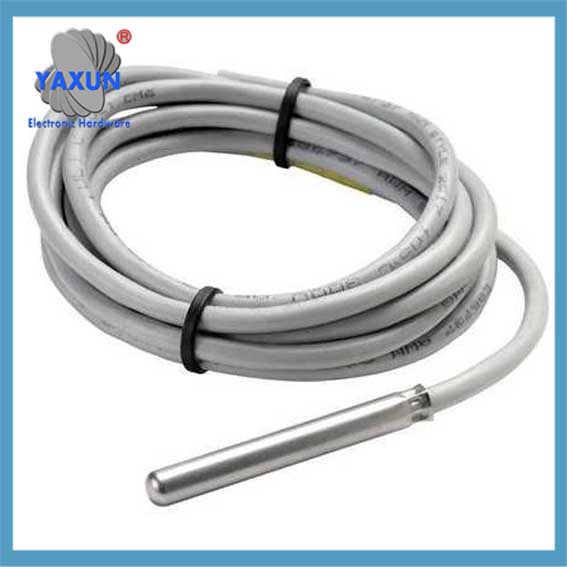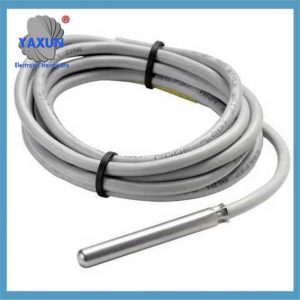Danh mục sản phẩm
Thẻ sản phẩm
NTC, PTC, PT100, DS18B20 cho cảm biến đầu dò nhiệt độ
Đầu dò cặp nhiệt điện: Nó sử dụng hiệu ứng nhiệt điện để đo nhiệt độ, và có các đặc điểm của phạm vi đo rộng và tốc độ phản hồi nhanh.
Đầu dò kháng nhiệt: Sử dụng tính chất mà điện trở của vật liệu kim loại hoặc chất bán dẫn thay đổi theo nhiệt độ để đo nhiệt độ, và có các đặc điểm của độ chính xác đo cao và độ ổn định tốt.
Đầu dò bán dẫn: sử dụng tính chất mà độ dẫn của vật liệu bán dẫn thay đổi theo nhiệt độ để đo nhiệt độ, và có các đặc điểm của kích thước nhỏ, Trọng lượng nhẹ và mức tiêu thụ năng lượng thấp.
NTC, PTC, PT100, Đầu dò nhiệt độ DS18B20 và cảm biến nhiệt độ đóng vai trò quan trọng trong lĩnh vực đo nhiệt độ. Sau đây là phần giới thiệu chi tiết về cảm biến thăm dò nhiệt độ:
Có nhiều loại cảm biến nhiệt độ, bao gồm:
Cặp nhiệt điện
Các cảm biến này được làm bằng hai kim loại không giống nhau kết nối tại hai điểm để tạo thành một điểm nối. Họ là đáng tin cậy, chính xác, và có thể hoạt động trên một phạm vi nhiệt độ rộng.
Máy dò nhiệt độ điện trở (RTD)
Các cảm biến này dựa trên sự thay đổi điện trở của kim loại khi nhiệt độ thay đổi.
Điện trở nhiệt
Các cảm biến này sử dụng các đặc tính nhiệt độ của điện trở bán dẫn, Điện trở thay đổi nào khi nhiệt độ thay đổi. Nhiệt nhiệt nhạy cảm và có độ chính xác cao so với chi phí của chúng.
Hệ số nhiệt độ âm (NTC) nhiệt điện trở
Các cảm biến này rất nhạy cảm và có thể đáp ứng với những thay đổi nhiệt độ rất nhỏ. Họ có phạm vi nhiệt độ của -50 ° C đến 250 °C.
Máy dò nhiệt độ điện trở
Các cảm biến này có hệ số nhiệt độ dương (PTC) và cung cấp các phép đo nhiệt độ chính xác. Tuy nhiên, Họ có độ nhạy kém.
1. Định nghĩa và nguyên tắc làm việc
Temperature thăm dò:
Sự định nghĩa: Đầu dò nhiệt độ là một thiết bị được sử dụng cụ thể để đo nhiệt độ, và thành phần cốt lõi của nó là một yếu tố nhạy cảm với nhiệt độ.
Nguyên tắc làm việc: Đầu dò nhiệt độ sử dụng các yếu tố nhạy cảm (chẳng hạn như cặp nhiệt điện, Điện trở nhiệt, chất bán dẫn, vân vân.) Để chuyển đổi thay đổi nhiệt độ thành tín hiệu điện để xử lý hoặc hiển thị mạch tiếp theo.
Cảm biến nhiệt độ:
Sự định nghĩa: Cảm biến nhiệt độ là một khái niệm rộng hơn bao gồm đầu dò nhiệt độ và mạch xử lý tín hiệu được kết nối với nó.
Nguyên tắc làm việc: Một cảm biến nhiệt độ không chỉ bao gồm một yếu tố nhạy cảm, nhưng cũng có một mạch xử lý tín hiệu có thể hoàn thành việc mua lại, Xử lý và đầu ra của tín hiệu nhiệt độ, thường ở dạng tín hiệu kỹ thuật số hoặc tương tự.
2. Các loại và đặc điểm
Loại thăm dò nhiệt độ:
Đầu dò cặp nhiệt điện: Nó sử dụng hiệu ứng nhiệt điện để đo nhiệt độ, và có các đặc điểm của phạm vi đo rộng và tốc độ phản hồi nhanh.
Đầu dò kháng nhiệt: Sử dụng tính chất mà điện trở của vật liệu kim loại hoặc chất bán dẫn thay đổi theo nhiệt độ để đo nhiệt độ, và có các đặc điểm của độ chính xác đo cao và độ ổn định tốt.
Đầu dò bán dẫn: sử dụng tính chất mà độ dẫn của vật liệu bán dẫn thay đổi theo nhiệt độ để đo nhiệt độ, và có các đặc điểm của kích thước nhỏ, Trọng lượng nhẹ và mức tiêu thụ năng lượng thấp.
Loại cảm biến nhiệt độ:
Cảm biến nhiệt độ tương tự: đầu ra tín hiệu tương tự, cần được chuyển đổi thành tín hiệu kỹ thuật số bằng các bộ chuyển đổi tương tự sang số để xử lý tiếp theo.
Cảm biến nhiệt độ kỹ thuật số: đầu ra trực tiếp tín hiệu kỹ thuật số, có khả năng chống can thiệp mạnh mẽ, Độ chính xác cao, và dễ dàng tích hợp vào hệ thống điều khiển.
Cảm biến nhiệt độ thông minh: tự chẩn đoán, Tự hiệu chỉnh, giao tiếp và các chức năng khác, và có thể nhận ra giám sát và kiểm soát từ xa.
3. Lựa chọn và ứng dụng
Các yếu tố chọn lọc:
Môi trường ứng dụng: Xem xét liệu môi trường đo được có điều kiện đặc biệt như sự ăn mòn, nhiệt độ cao, áp lực cao, vân vân., Vì vậy, để chọn các vật liệu và mức độ bảo vệ phù hợp.
Phạm vi đo: Chọn một cảm biến phù hợp theo phạm vi nhiệt độ cần đo để đảm bảo rằng cảm biến có thể đo chính xác trong phạm vi yêu cầu.
Yêu cầu chính xác: Theo các yêu cầu chính xác của ứng dụng đo nhiệt độ, Chọn một cảm biến có độ chính xác tương ứng.
Ngân sách chi phí: Dưới tiền đề đảm bảo hiệu suất, Xem xét các yếu tố chi phí và chọn cảm biến hiệu quả chi phí.
Các khu vực ứng dụng:
Tự động hóa công nghiệp: Được sử dụng để theo dõi sự thay đổi nhiệt độ trong thiết bị công nghiệp, máy móc và quy trình sản xuất để đảm bảo hoạt động bình thường của thiết bị và chất lượng sản phẩm.
Ngành y tế: được sử dụng trong thiết bị y tế, Công cụ giám sát nhiệt độ và thiết bị lưu trữ thuốc để theo dõi nhiệt độ bệnh nhân, Nhiệt độ xung quanh và điều kiện lưu trữ thuốc.
Ngành công nghiệp ô tô: được sử dụng trong động cơ xe điện, tụ điện, Bộ chuyển đổi DC, Hệ thống sạc, cũng như động cơ ô tô, Hộp số, Hệ thống điều hòa không khí và hệ thống ống xả để giám sát và kiểm soát nhiệt độ của các chất lỏng và khí khác nhau.
Ngành công nghiệp chế biến nông nghiệp và thực phẩm: được sử dụng trong nhà kính nông nghiệp, kho lạnh, Thiết bị chế biến thực phẩm và phương tiện vận chuyển để giám sát và kiểm soát nhiệt độ của các sản phẩm nông nghiệp và thực phẩm.
Các lĩnh vực khác: chẳng hạn như công nghiệp điều hòa không khí và điện lạnh, ngành công nghiệp quân sự và hàng không vũ trụ, Internet của ngành công nghiệp, vân vân. cũng được sử dụng rộng rãi.
Iv. Sử dụng và bảo trì
Cài đặt: Cài đặt cảm biến chính xác theo hướng dẫn cài đặt để đảm bảo liên hệ tốt giữa cảm biến và đối tượng được đo và tránh các lỗi đo lường do cài đặt không đúng.
Wires: Kết nối chính xác đường tín hiệu và đường nguồn của cảm biến để đảm bảo tính ổn định và độ chính xác của truyền tín hiệu.
sự định cỡ: Hiệu chỉnh cảm biến thường xuyên để đảm bảo rằng độ chính xác đo lường của nó đáp ứng các yêu cầu của ứng dụng. Quá trình hiệu chuẩn thường liên quan đến việc đặt cảm biến trong môi trường nhiệt độ đã biết, So sánh sự khác biệt giữa giá trị đầu ra của nó và giá trị tiêu chuẩn, và thực hiện các điều chỉnh cần thiết.
BẢO TRÌ: Làm sạch và duy trì cảm biến thường xuyên để tránh bụi, bụi bẩn, vân vân. ảnh hưởng đến hiệu suất đo của cảm biến. Đồng thời, Hãy chú ý kiểm tra xem kết nối cáp có bị lỏng hay bị hỏng không, và thay thế các bộ phận bị hư hỏng trong thời gian.
Tóm lại, Các cảm biến thăm dò nhiệt độ có một loạt các ứng dụng và một vị trí quan trọng trong lĩnh vực đo nhiệt độ. Khi chọn và sử dụng chúng, Cần phải xem xét toàn diện dựa trên các kịch bản và yêu cầu ứng dụng cụ thể để đảm bảo tính chính xác và độ tin cậy của kết quả đo lường. Nếu bạn có bất kỳ câu hỏi nào khác hoặc cần giúp đỡ thêm, Xin vui lòng cho tôi biết.
Liên hệ với chúng tôi
Đang chờ email của bạn, chúng tôi sẽ trả lời bạn trong vòng 12 giờ với thông tin có giá trị bạn cần.
 English
English العربية
العربية Български
Български 粤语
粤语 中文(简体)
中文(简体) 中文(漢字)
中文(漢字) Nederlands
Nederlands Suomi
Suomi Français
Français Deutsch
Deutsch Ελληνικά
Ελληνικά Magyar
Magyar Italiano
Italiano 日本語
日本語 한국어
한국어 Polski
Polski Português
Português Română
Română Русский
Русский Slovenščina
Slovenščina Español
Español Svenska
Svenska ภาษาไทย
ภาษาไทย Türkçe
Türkçe Tiếng Việt
Tiếng Việt












